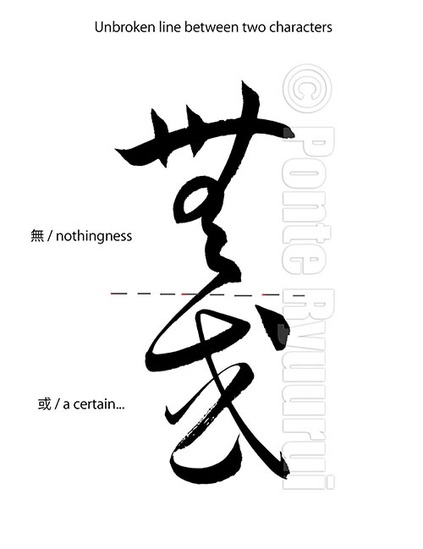 To read part 1 and 2 of this tutorials, please see the cursive script tutorials page. Visible unbroken line, that connects two or more characters (some masterpieces have lines with 20 characters or more being merged in a single brush stroke), is a technique often used by Chinese and Japanese calligraphers. The way of connecting two characters is not random, and it should by no means not distort the structure and balance of either of the Chinese characters. It is performed with a single brush stroke, without the brush leaving the paper surface. Merging more than 3 character with the unbroken line technique is more common in Japanese calligraphy than Chinese calligraphy. This tradition takes its origin in Japanese kana calligraphy, in which hiragana (平仮名) and hentaigana (変体仮名) syllabograms are combined in long ribbons of ink. There are also styles of calligraphy which are based on writing the entire text in one brush stroke, which I believe was initiated by a brilliant calligrapher of the late Ming Dynasty (明朝, 1368 - 1644), Wang Duo ( 王鐸, 1592 - 1652), who was inspired by the ippitsu technique (一筆書, lit. one brush stroke calligraphy) found in the Chinese calligraphy masterpieces by Wang Xianzhi (below) of the Jin dynasty (晉朝, 265 - 420). One of the most famous Chinese experts on the unbroken line, was Wang Xianzhi (王献之, 344 - 386), the 7th and most talented son of famous Wang Xizhi (王羲之, 303 - 361), though the unbroken line had appeared much earlier. It was a technique used already during the late Han Dynasty (漢朝, 206 B.C.E. - 220 C.E.) by a brilliant calligrapher, Zhang Zhi (張芝, died 192), who excelled in the cursive script (草書) of Chinese calligraphy. Visible unbroken line is very difficult to execute in a way that will not ruin the composition and the energy flow (行氣), which are the essential elements of good calligraphy. Diligent studies of cursive script masterpieces is a sine qua non step towards mastering this technique. Suggested calligraphers are, except those three mentioned above, Zhang Xu (張旭, he exact dates of birth and death are unknown) and the monk Huai Su (懷素, 737–799 C.E.), of the Tang dynasty (唐朝, 618 – 907), who are well known as “Crazy Zhang and Drunk Su (顛張醉素)".
|
Categories
All
AuthorPonte Ryuurui (品天龍涙) Archives
August 2020
|

 RSS Feed
RSS Feed
